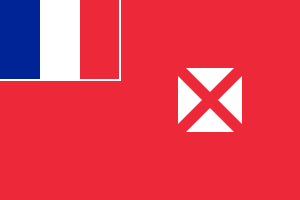Wallisian language
- This article deals with the language of Wallis Island, "Wallisian," also known as "Fakauvea" or "East Uvean." For the similarly named language of Ouvéa, New Caledonia, see West Uvean language (Fagauvea).
| Wallisian | |
|---|---|
| Fakaʻuvea | |
| Native to | Wallis and Futuna |
Native speakers | 10,400 (2000)[1] |
| Language codes | |
| ISO 639-3 |
wls |
| Glottolog |
wall1257[2] |
Wallisian or ʻUvean (Wallisian: Fakaʻuvea) is the Polynesian language spoken on Wallis (also known as ʻUvea). The language is also known as East Uvean to distinguish it from the related West Uvean language spoken on the outlier island of Ouvéa near New Caledonia. Wallisian tradition holds that the latter island was colonised from Wallis Island in ancient times.
Wallisian may be most closely related to Rennellese. It is also closely related to Tongan, though part of the Samoic branch, and has borrowed extensively from Tongan due to the Tongan invasion of the island in the 15th and 16th centuries.
Alphabet
The standard 5 vowels: a, e, i, o, u, with their lengthened variants: ā, ē, ī, ō, ū.
The consonants: f, g (always pronounced as ŋ (ng)), h, k, l, m, n, s (rare, usually from foreign words), t, v, '.
The ʻ, representing the glottal stop (see also okina), is known in Wallisian as fakamoga (belonging to the throat). The fakamoga is nowadays taught at schools, and can be written with straight, curly or inverted curly apostrophes. Similarly the macron (Wallisian: fakaloa, 'to lengthen') is now taught in schools to mark long vowels, even though the older generation has never marked the glottal stop or vowel length.
For example: Mālō te ma'uli (hello)
Vocabulary
| Phoneme correspondences | ||||||||||
|---|---|---|---|---|---|---|---|---|---|---|
| Phoneme | Proto-Polynesian | Tongan | Samoan | Wallisian | English | |||||
| /ŋ/ | *taŋata | tangata | tagata | tagata | person | |||||
| /s/ | *sina | hina | sina | hina | grey (of hair) | |||||
| /ti/ | *tiale | siale | tiale | siale | flower | |||||
| /k/ | *waka | vaka | vaʻa | vaka | canoe | |||||
| /f/ | *fafine | fefine | fafine | fafine | woman | |||||
| /ʔ/ | *matuqa | motuʻa | matua | matua | parent | |||||
| /r/ | *rua | ua | lua | lua | two | |||||
| /l/ | *tolu | tolu | tolu | tolu | three | |||||
Influence from other languages
Wallisian may be most closely related to Rennellese. It is also closely related to Tongan, because of former Tonga invasions in Wallis. For instance, the past form "ne'e" comes from Tongan.
Wallisian has been heavily influenced by French. French missionaries arrived at the end of the 19th century; in 1961, Wallis and Futuna became a French oversea territory and French is now the official language. According to many linguists such as K. Rensch French did not affect much the language in the beginning but is now profoundly transforming Wallisian. Many neologisms have been created by transliterating French words into Wallisian, as in the vocabulary of politics. Words such as Falanise (France), Telituale (Territory), politike, (politics), Lepupilika (Republic)..., many technical words (telefoni, televisio...), food that was brought in Wallis by the Europeans (tomato, tapaka (tobacco, from fr tabac, ), alikole (alcohol), kafe (coffee, from fr café)), etc. are borrowings from French.
When the missionaries came, they also introduced many Latin words, mainly for religious purposes. Jesus Christ was rendered into Sesu Kilisito, words like komunio (communion), kofesio (confession), temonio (devil, from demonio, fr démon), but also some non religious vocabulary : hola (time, hour (lat. hora)) ; hisitolia (history (lat. historia)) were introduced and are now part of the everyday Wallisian language. Not all religious words have been borrowed, though. Missionaries also tried to use existing concepts in Wallisians and give them a new Christian meaning. Thus Tohi tapu ("sacred book") refers to the Bible, while aho tapu ("holy day") means Sunday and Po Tapu ("sacred night") is Christmas; the concept of Trinity was translated into Tahitolu tapu which literally translates to "one-three holy". Missionaries also introduced the days of the week into the language, using the Latin ecclesiastical style of naming weekdays with feria (translitterated into felia), much like in Portuguese.
Wallisian has also been influenced by English, especially after the American army set a military base on the island in 1942. Loanwords such as puna (spoon), motoka (car, from motor car), famili (family), suka (sugar), peni (pen), tini (tin) etc. come from English. However, English loanwords started entering the Wallisian language way before World War II since sailors and merchants already had frequent contacts with the local population.
References
- ↑ Wallisian at Ethnologue (18th ed., 2015)
- ↑ Hammarström, Harald; Forkel, Robert; Haspelmath, Martin; Bank, Sebastian, eds. (2016). "Wallisian". Glottolog 2.7. Jena: Max Planck Institute for the Science of Human History.
Bibliography
- Livingston, Andrew (2016). East Uvean. A condensed grammar (PDF) (master's thesis in linguistics). University of Washington. p. 190.
- Moyse-Faurie, Claire (2016). Te lea faka'uvea - le wallisien (PDF). Les langues du monde (in French). Peeters. p. 276. ISBN 978-90-429-3376-7.
External links
| Wallisian language test of Wikipedia at Wikimedia Incubator |
